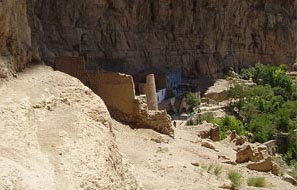The Mission of the Báb
The birthday of the Bab and Baha'u'llah are celebrated as "Twin Holy Days." This post tells you about the Bab, which is Persian for "the Gate."
Born in Shiraz, a city in southern Iran, on 20 October 1819, the Báb was the symbolic gate between past ages of prophecy and a new age of fulfilment for humanity. His primary purpose was to awaken the people to the fact that a new period in human history had begun, one which would witness the unification of the entire human race and the emergence of a world civilization of spiritual and material prosperity. This great day would be established through the influence of a divinely inspired Educator, whom the Báb referred to as “He Whom God shall make manifest.” It was His own mission, the Báb declared, to herald the coming of this promised Manifestation of God. The Báb explained that the new Manifestation would usher in an age of peace and justice that was the hope of every longing heart and the promise of every religion. The Báb instructed His followers to spread this message throughout the country and to prepare people for this long-awaited day.
Born in Shiraz, a city in southern Iran, on 20 October 1819, the Báb was the symbolic gate between past ages of prophecy and a new age of fulfilment for humanity. His primary purpose was to awaken the people to the fact that a new period in human history had begun, one which would witness the unification of the entire human race and the emergence of a world civilization of spiritual and material prosperity. This great day would be established through the influence of a divinely inspired Educator, whom the Báb referred to as “He Whom God shall make manifest.” It was His own mission, the Báb declared, to herald the coming of this promised Manifestation of God. The Báb explained that the new Manifestation would usher in an age of peace and justice that was the hope of every longing heart and the promise of every religion. The Báb instructed His followers to spread this message throughout the country and to prepare people for this long-awaited day.
The Báb’s message aroused hope and excitement among people from every walk of life. Although a number of prominent Muslim clerics accepted the Báb, many others felt insecure and threatened by His growing influence and feared their entrenched positions of privilege and authority would be threatened by the empowerment of the people. They denounced the Báb’s teachings as heretical and set out to destroy Him and His followers. Controversy raged in mosques and schools, in streets and bazaars throughout the land.

As a result, the Báb was banished—from city to city, from prison to prison. But none of the plans His enemies devised could prevent His influence from spreading. In every place He was sent, His grace and the magnetic attraction of His personality won the admiration of civic leaders and townspeople. Callous prison governors and soldiers guarding Him became His followers. Each time, believing they were extinguishing the flame of His influence, the authorities merely added fuel to His life-giving light. In time, the Báb’s popularity grew to such an extent that some prominent clergymen appealed to the government to have Him executed. The Bábís, shut off from their leader, boldly defended themselves against the full force of the state, which was summoned for their destruction. Thousands of His followers—men, women and children—suffered cruel and brutal deaths.
The Execution of the Báb
In 1850, Mirza Taqi Khan (Grand Vizier of Nasiri’d-Din Shah) ordered the Báb’s execution. When the guards came to take Him on the day of His execution, 9 July, the Báb told them that no "earthly power" could silence Him until He had finished all that He had to say. Thousands crowded the rooftops that overlooked the barracks square in Tabríz where the Báb was to be executed by a firing squad. In the intense heat of the noonday sun, He was suspended by ropes against a wall of the barracks, along with a young follower. A regiment of 750 soldiers opened fire in three successive volleys. When the smoke and dust of the gunpowder cleared, the Báb had vanished from sight. Only His companion remained, alive and unscathed, standing beside the wall on which they had been suspended. The ropes by which they had been hung alone were severed. After a search, the Báb was found back in His cell, continuing the conversation with His secretary that had been earlier interrupted.
“Now you may proceed to fulfil your intention,” the Báb told His captors. Again, He was brought out for execution. After the first regiment refused to fire, another was assembled and ordered to shoot. This time the bodies of the Báb and His young follower were shattered. A whirlwind of dust engulfed the city, blotting out the light of the sun until nightfall.
In 1909, after being hidden away for more than half a century, the Báb’s remains were finally interred on Mount Carmel in the Holy Land. Today, entombed in an exquisite golden-domed Shrine, encompassed by spectacular terraced gardens and fountains, the Báb rests in conspicuous glory, a symbol of the triumph of the Cause that He heralded over the fiercest of opposition. Throughout the world, millions recognize the Báb as the divinely inspired Herald of the Bahá’í Faith and turn reverently to His Writings to discover the “resplendent Light of God.”
No comments:
Post a Comment